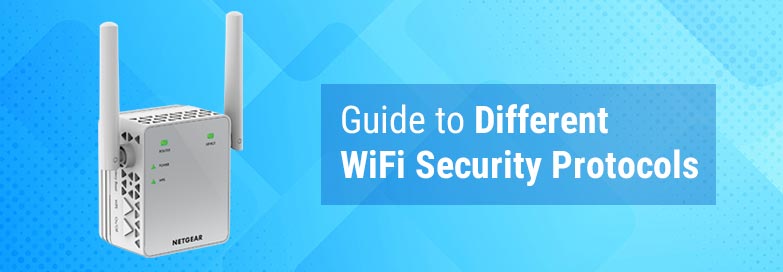The increasing cyberattacks have made it difficult for individuals and businesses to safeguard their sensitive data. Whether it is Brute Force or Man-In-The-Middle (MITM) attacks, there is no shortage of techniques hackers and data thieves can use to steal your personal data. The first thing they target is an unsecured device or a WiFi network. This forced the tech world to come up with a variety of WiFi security protocols to counter the problem.
But, for an average internet user this is not an easy concept to grab. Thus, tech experts have come up with a guide for the same. Let us check out the different WiFi security protocols.
Different Types of WiFi Security Protocol
Every WiFi security protocol is different. It is why you should keep a check on which one your home or office WiFi device comes with.
Come! Let us check out the 4 different types of WiFi protocols.
1. Wired Equivalent Privacy (WEP)
WEP made its entry in the networking world way back in 1997. It is the oldest WiFi security protocol, but still found in many of the modern day older devices. Unfortunately, it is the least secured WiFi protocol.
2. WiFi Protected Access (WPA)
WPA came as the successor of WEP owing to its many flaws. This WiFi protocol introduced additional features including Temporal Key Integrity Protocol (TKIP). The TKIP used 128-bit encryption key that is harder to break for hackers and data thieves.
3. WiFi Protected Access 2 (WPA2)
WPA2 is the successor to WPA. It replaces the TKIP with Counter Mode Cipher Block Chaining Message Authentication Code Protocol (CCMP). This feature does a better job at encrypting data. This helped WPA2 solidify its position as the best WiFi security protocol since 2004.
It performed so well that in 2006 the WiFi Alliance announced all upcoming WiFi devices would come with the WPA2 protocol.
On that note, if you have a Netgear WiFi router connected to a Netgear WiFi extender, you can check the WiFi security standard by accessing mywifiext.net web page.
4. WiFi Protected Access 3 (WPA3)
WPA3 is the future of WiFi networking security protocol. It comes with improved encryption standards for public WiFi networks. This makes it easy to fend off hackers and data thieves looking to exploit a user’s online information.
Want to know the best part? It is easy to connect to a WPA3-enabled router with a device having no display. This feature makes it impossible for hackers to access sensitive information even with Brute Force attacks.
Now, there are many who question :-
Why Does a WiFi Protocol Matter So Much?
WiFi security protocol is not only a tech term you can use to sound cool to others. These serve an important purpose. Different WiFi security protocols secure your home or office WiFi network as well as routers against unauthorized access. It is why tech experts recommend that you have a WiFi device with the latest WiFi security protocol.
That said, there are 2 reasons why the WiFi device you have should contain the latest WiFi protocols.
- Older WiFi protocols were designed after getting knowledge of how hackers attacked WiFi networks. The modern WiFi protocols have overcome many of the limitations these standards had and improved them to counter cyberattacks prevalant today.
- The longer a WiFi security protocol is around, the more time hackers have to crack its security layer. For example, WEP stayed for a long time and that is the reason why hackers are now able to bypass this WiFi protocol with ease.
Tech experts have come up with a tip to keep your networksecure.
Pro Tip: Now, if you want to connect the WiFi router to a Netgear EX3700 WiFi extender, complete the Netgear EX3700 setup process to secure the network and device against intrusion.
Conclusion
Check out this guide to know about the different types of WiFi security protocol. Knowing these will help you choose a WiFi device that comes packed with the latest security.

